RSI
Awards
|
Repubblica
Sociale Italiana Awards
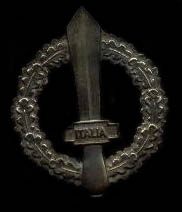
The Official foundation of the Armed Forces of the "Repubblica Sociale Italiana (RSI)" was on 28 October 1943, which gave birth to the new Republican Army on 9 September 1943.
Many Italian units that did not accept the armistice, went on to fight on the German
side.
Four Infantry Divisions under the new RSI Government were formed and trained in Germany: The "Italia," "Littorio," "San Marco" and "Monterosa" Divisions.
Please note that in the near future I will be adding more information relating to these Divisions in my Feldpost section under Italian SS Feldpost.
Many types of insignia and awards were issued and used by these RSI volunteers, such as those illustrated in the examples below.
|
|
The
Italian RSI Honor Badge
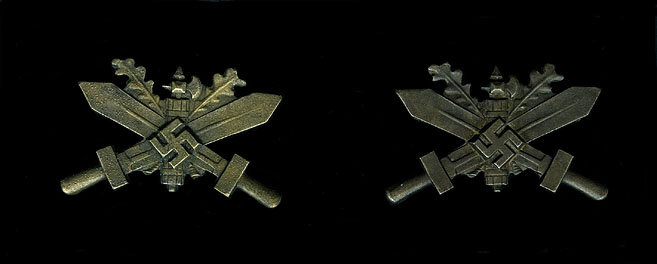
Award given to those Italian troops that finished their military
training course in Germany.
This award was instituted on July 15, 1944 and was
rendered to those soldiers of the four RSI Divisions and their German instructors.
In accordance to the Italian Decree, Circular no. 160:
"Giornale Militare Ufficiale"
dated 1944: "In order to cement more and more comradeship ties with the allied army,
the Duce has authorized a special badge to be issued to the soldiers of the Divisions
under training and to their instructors."
A gilded metal for Officers and silvered
for NCOs and enlisted. The badge was made of solid stroke metal and the reverse has a safety pin held by a fixed round small plate. The award was worn above the right breast
pocket.
There are many reproductions but can easily be detected.
Most fakes have some metal contents on top of the leaf and fascio. In addition, originals should have the lower leg of the swastika smaller in size as shown on the badges above.
RSI Skull
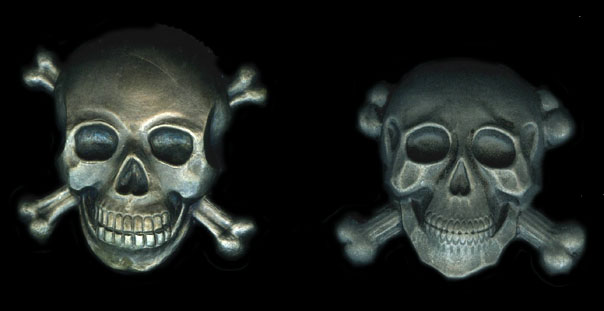
These skulls with crossed bones were made of zama, aluminum or steel sheet by
various Italian firms. On the back it has different attachments (safety
pins, long pins, cramps). These decorations were worn as cap badges,
collar badges and coat badges according to their unit. These decorations were
popular with the Italian Black Brigades and were made even before the Armistice.
|
|
Medagli di
Propaganda Anti-Partigiana
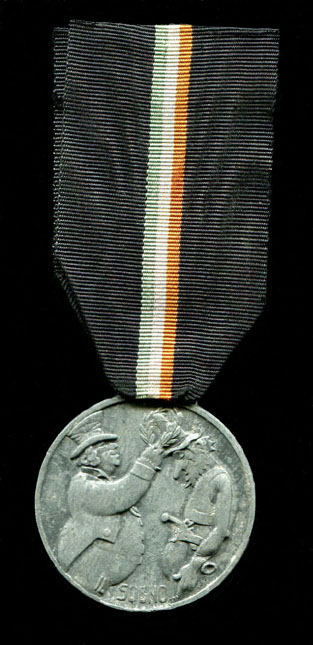
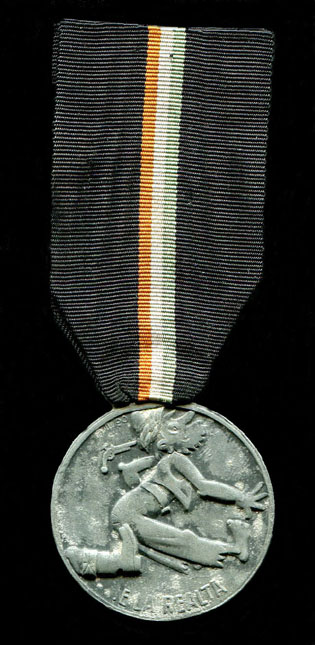
The "Medagli di Propaganda Anti-Partigiana" (Propaganda Medal Anti-Partisan) was
made by the German Propaganda "STAFFEL" (Detachment). This detachment produced
and disseminated propaganda leaflets and cards with pro-German and anti-allied scenes and text.
The detachment is known for producing series of leaflets and cards with the slashed zero follow by the
code 0I through 0IV.
The medal is made of zama. The obverse of the medal illustrates the British national personification
of John Bull awarding a partisan below has the inscription "SOGNO" (the Dream). The
reverse the partisan is being kicked with the inscription below "LA REALTA" (The Reality).
On the top it has the German series marking "ØII/90."
The ribbon is black with a small centered tri-color green-white-red stripe. The ribbon has also been
found on other Italian awards and has been reproduced.
This medal is very rare so far no known
reproductions of this medal has surface on the internet.
A German propaganda leaflet was produced in February 2, 1945, illustrating this medal.
|
|
RSI
M44 Field Cap
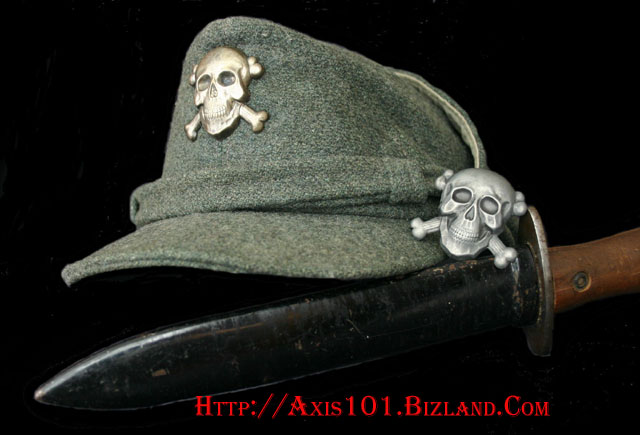
A rare
1944 pattern field cap made of Italian coarse wool. The period RSI skull is
attached to a stiff cardboard, which is inside the crown of the cap. The interior
lining is light tan color I believe that is made of Rayon.
A 1939 dagger with black scabbard widely issued to paratroopers and black shirt members and a RSI skull.
|
|
RSI Pilot Badge
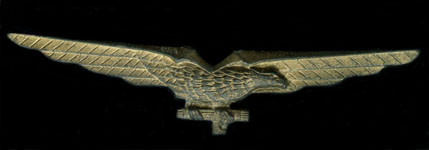
Interesting badge worn in 1943 by members of the Aeronautica Nazionale Republicana (ANR), whose pilots represented the newly formed Republica Sociale Italia (RSI).
The badge above looks the same as the 1935-1943 style pattern badge but with the Royal
Crown removed. Later they were manufactured with no Royal Crown.
|
|
Medaglia 63 Legione CC.NN. d'Assalto Tagliamento
During WW2 Italy raised elite units referred as "M" battalions (the "M" stood for Mussolini). These units were political voluntary militias and fought under the Kingdom of Italy, operating between 1941 and 1943 and later under the Repubblica Sociale Italiana (RSI) from 1943 to 1945.
One of the famous units that participated was the 63rd Legion CC.NN. Assault "Tagliamento." It was mobilized in February 1941 and was composed of approximately 1191 officers and men. It was later assigned to the Italian Expeditionary Corps in Russia.
The group "Tagliamento" was not originally designated as a "M" unit, but were recognized as such because of the courage and valuable contribution it demonstrated during the eastern-front battles when it was part of the CSIR (Italian Expeditionary Corps in Russia).
When the new Italian Social Republic was established on 23 September 1943, the 1st Assault Division "M" Tagliamento was immediately formed and composed of mostly veterans and from men from North-East regions. The division mostly fought in the Apennine mountains. It eventually assisted the German defenses in the stretch of the Gothic Line. The unit fought anti-partisans and gained the reputation as fierce and brutal fighters. It was disbanded in May 1945, most of the men captured by partisans were executed.
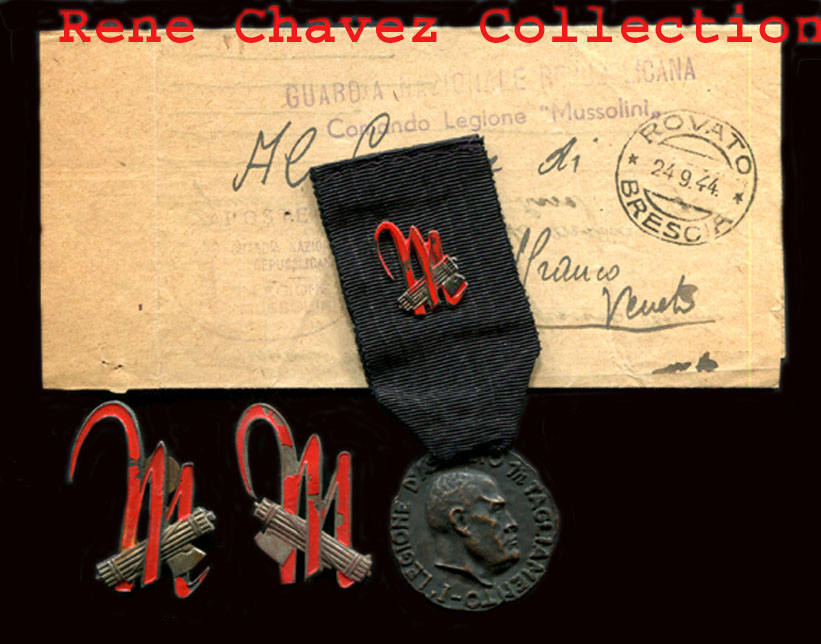
Above is a pair of metal insignia showing the red painted "M" with fascio. These insignia were attached on the collar tabs.
Next is a very rare medal manufactured during the Italian Social Republic and awarded to members of the "First Legion Assault M Tagliamento." The medal was engraved by Alberto Martinola, who chose as a symbol for this coin the "M" Mussolini.
The medal is bronze but has been blackened over the course of time. The obverse with the right-facing bust of Benito Mussolini surrounded by the inscription "I LEGIONE D'ASSALTO M TAGLIAMENTO" and engraver marked "A. MARTINOLA."
The reverse inscribed in the center is "soli quei forti scesero onta ai fratelli in campo" surrounded by an open-ended wreath composed of oak leaves at the left and laurel leaves at the right. On the top of the wreath is the symbol with "M" and fascio. Attached to the black ribbon is a small clasp showing the red painted "M" with fascio.
In the background is a postal cover mailed dated September 24, 1944 by the Command Legione Mussolini.
|
|
Decima Flottiglia Mas
The Decima Flottiglia MAS (Decima Flottiglia Mezzi d'Assalto) was an elite Italian commando frogman unit of the Regia Marina (Italian Royal Navy) created during the Fascist regime. Decima MAS was active during the Battle of the Mediterranean and took part in a number of daring raids on Allied shipping. These operations used surface boats (such as the Sinking of HMS York), manned torpedoes (the Raid on Alexandria) and Gamma Frogmen (against Gibraltar). During the campaign Decima MAS took part in more than a dozen operations which sank or damaged 5 warships and 20 merchant ships totalling 130,000 GRT (Gross Register Tonnage). In 1943, after the Italian dictator Benito Mussolini was ousted, Italy left the Tripartite Pact and joined the Allies.
Some of the Decima MAS men who were stationed in German-occupied northern Italy enlisted to fight for Mussolini's newly-formed Italian Social Republic (Repubblica Sociale Italiana or RSI) and retained the unit title, but were primarily employed as an anti-partisan force operating on land. Other Decima MAS men in southern Italy or other Allied-occupied areas joined the Italian Co-Belligerent Navy as part of the Mariassalto (Naval Assault) unit.
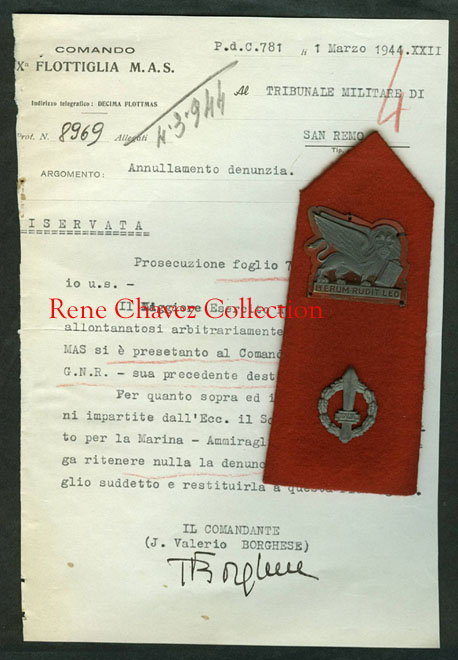
Illustrated is a wondeful rare document signed by the Commander of the Decima Mas the Black Prince "Junio Valerio Borghese" who took command in May 1943.
Also shown is a red collar Tab attached with the metal "San Marco" Lion insignia and below the wreathed gladius insignia.
Decima Flottiglia Mas Shield
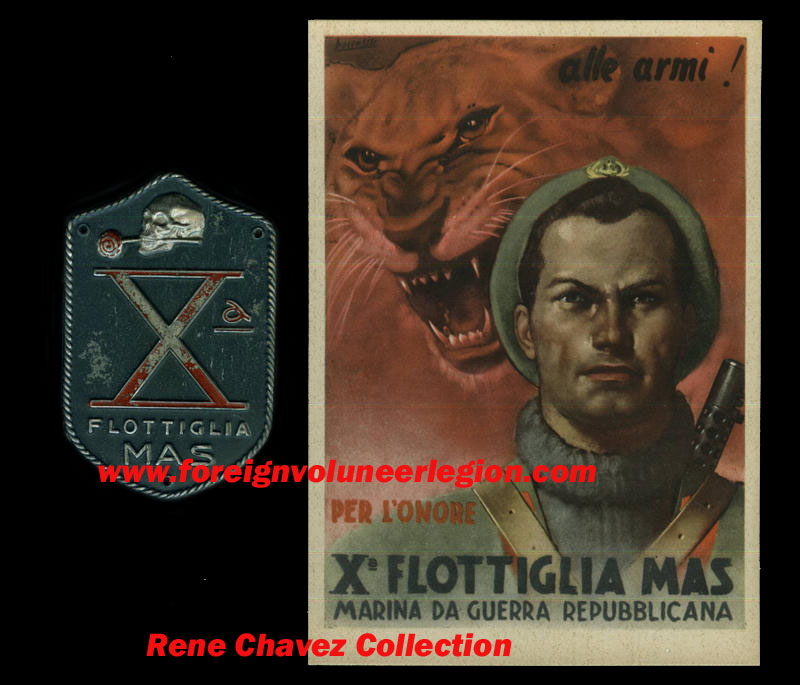
Members of the Decima Mas were issued with variations of a metal shield that was worn on their left sleeve of their uniforms. The shield shown above was made by the Italian firm "Bregonzio" of Milan. The painter Giovanni Fumagalli was commissioned by the Commander Borghese to study the project for design of the shield. The badge depicts a silver skull holding a red rose between the teeth. It has been said that the Lieutenant commander Salvatore Todaro during his last days of life, coin the representation of the emblem skull holding a rose that "death in combat is something beautiful and fragrant." Below is a large red painted Roman numeral "X" (Tenth). Below is the silver inscription relief "FLOTILLA MAS" on a painted blue-green background surrounded by a gilded chain linked. The distinctive was made
of Italian war metal called zama worn on land and of brass for sea duty. The dimensions of the shield is 49 mm. wide by 76 mm. tall and weighs 15 grams.
Next is a very well known propaganda recruitment card designed by the famous RSI artist Gino Boccasile. illustrated is a Decima Mas volunteer and in the background is the face of a lion growling, which represented the unit. The inscription on top says "Alle Armi" (Joined the Army) and below the inscription "PER L'ONORE" (FOR THE HONOR). At the bottom of the card there is the inscription "X FLOTTIGLIA MAS MARINA DA GUERRA REPUBBLICANA" (X MARINE FLOTILLA MAS NAVAL WAR REPUBLIC).
|
|
SS Battalion
Debica
In September to the end of February 1943, a separate SS-Battalion was
being formed in the SS Heidelager Training Grounds at Debica, Poland. Major
Fortunato, who was a former Bersaglieri officer who served in Russia, was tasked
in the selection of new recruits loyal to the Germans.
Most of the volunteers
came from the Italian XXXI Tank Battalion of the Lombardia Division and the elite
Alpine Julia Division.
These volunteers followed a different training program from
those of Munsigen. The formation, which had 20 officers and 571 men, was referred
as "SS-Battalion Debica." For the most part these troops were considered as Waffen-SS
men. By early March 1944, the men of the SS-Battalion Debica were provided with
German Parachute uniforms.
On 21 March 1944, the SS-Battalion Debica was deployed
to do anti-partisan operations around the Pellice Valley, southwest of Turin.
Anti-partisan operations lasted till May 1944.
On 12 April, the SS-Battalion Debica
was incorporated into SS Battle Group "Diebitsch." However, it was not deployed to
the Anzio Front Lines. During April and May, the battalion fought around Nocera
Umbra, Assisi and San Severino Marche. During these anti-partisan operations the
battalion suffered 50 casualties. New volunteers were able to keep the battalion
with strength of 500 men with 20 officers.
In early June, SS-Battalion Debica, which
subordinated to the German 1st Parachute Corps fought on the northern side of Rome
along the Tyrrenic Coast. Once again the battalion suffered heavy losses while
fighting American tank units in the Tyrrenic Coast and against partisans behind the
German lines. The 200 or so survivors were dispersed into small battle groups.
On 16 June the SS-Batalion Debica was ordered to Florence to help guard the defensive
positions of the Gothic Line under Army Group von Zangen. Because the battalion was
under strength it was sent to Pinerolo for refitting. By August, the battalion was in
full strength and was tasked to take part in Operation Nightingale against partisan
strong points in the Chisone and Susa Valleys.
On September 7 the SS-Battalion
Debica became part of the new "Waffen-Grenadier Brigade der SS (Italian nr. 1).
The battalion was converted into the new "Waffen-Fusilier Btl. der SS 59" (59th
Waffen-SS Reconnaissance Battalion).
|
|
Italian SS headdgear insignia
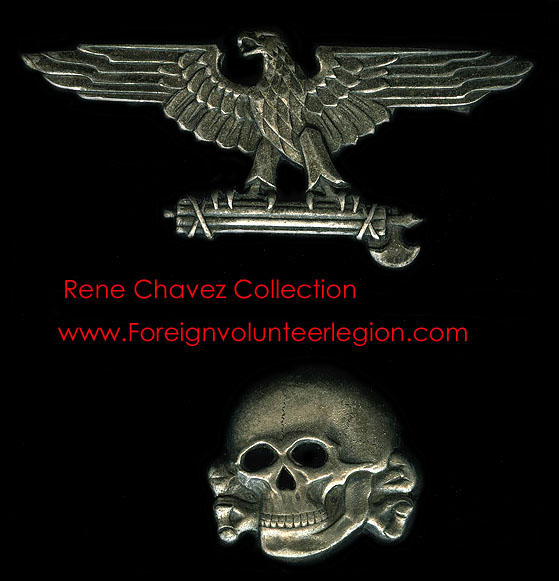
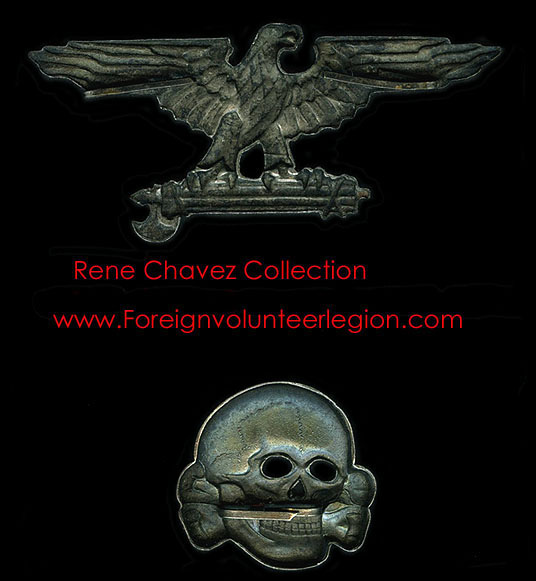
The white metal badges portraying the republican eagle holding the fascio and the skull were applied
in the center of the visor or cap; in some cases the eagle was worn on the left side of the
field cap. The badges were die stamped and produced by FM Lorioli di Milano (minting
die no. 04944/D), as a result from the sample approved by the German authorities.
The back of the badges were held by means of two long prongs.
|
|
SS Italian insignia
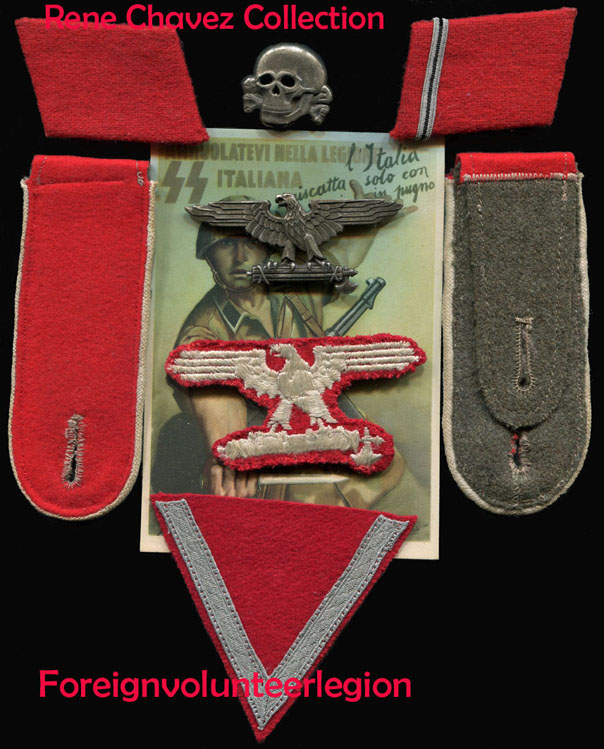
Italian SS Insignia.
In February 1944, the volunteers of the Italian SS Legion received new collar tabs with red wool backing. The rank insignia was displayed on both sides of the collar.
The Italian made red wool collar tabs were a tad larger in size then the German standard SS tabs, however, because of supply problems not all SS Italian personnel received the insignia. In addition, many of these red collar tabs were German made, which were distributed among the Italian SS volunteers.
In June 1944, the German SS directive authorize certain units the right to
wear the more popular black collar tabs. The republican eagle
clutching the fasces on red background was also replaced with the black wool color
backing.
The Italian SS-eagle armshield shown in the middle was made and issued in Italy.
According to an article written by Dr. Marco Novarese, he indicates that the "Republican
Eagle" clutching a fasces originated in September 1943 from a meeting between Hitler and
Mussolini.
Mussolini had asked for a special insignia that would represent the Fascist
ideology for his Milizia, hence the founding of the national emblem, which represented the new RSI Government.
The first such insignia
were distributed in February 1944, after the formation of the first Sturmbrigade.
Initially the republican eagle was embroidered on a red wool background and was worn on the left sleeve of the tunic.
Also shown is a pair of extremely rare SS Italian shoulder boards,The boards have white piping. These boards were used for a very short period of time.
Below is a rare SS Italian chevron, I believe it is German made. The front and back is made of red wool. There also exist a slightly smaller size red chevron, which has a felt wool on the front and the reverse has a stiffer weave. Nevertheless both types are rare and definitely worn by members of the Italian SS.
In the center is a rare SS Italian propaganda recruiting postcard by the famous Italian artist Gino Boccasile.
The SS-Battalion Debica was the first unit given the honor to wear the black collar tab and the
Italian eagle on a black wool background because of their proving combat record during
the Anzio campaign.
The SS tabs were not authorized, only Italians that had transfered from other
Waffen-SS formations were allowed to wear the SS collar tab.
In autumn 1944, a new collar insignia
with the three arrows and the yoke was distributed to the Italian SS combat troops. It should be
noted that an Italian special unit that fought during the Spanish civil war was called the "Red Arrows."
However Dr Novarese indicates that this symbol was taken from Wewelsburg castle. Two Italians were
invited to visit the castle, the philosopher Julius Evola and Waffen-Hauptsturmführer der SS Leale Martelli.
Martelli was the former commander of the recruiting office in Florence.
It is not known whether or not SS-Ogruf. Wolff personally authorized the collar tab. No word of the new
Italian collar tab was ever passed on to the SS Main Office in Berlin.
The SS Headquarters had their own
ideas of the collar tab, which depicted the fasces with an axe on a black background. These collar tabs were
certainly manufactured but never distributed.
|
SS German made Italian insignia
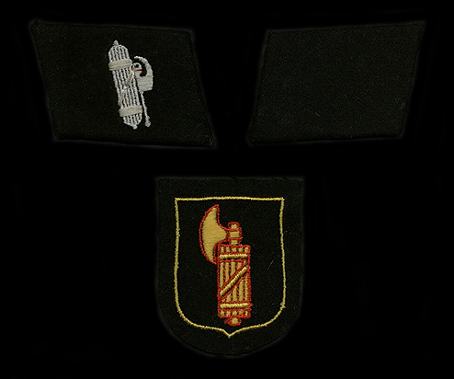
The German made Italian SS Insignia shown above was issued to members of the "29. Waffen-Grenadier Division der SS Italienische Nr 1." However, there is
no evidence indicating that this collar tab was actually issued or worn most likely they, either were never authorized or never made it to their destination.
The reorganization of the 29th Italian SS Division was constantly being interrupted
by the deployment of separate units. Most of these battle groups were engaged fighting desperate battles against well trained
strong Partisan formations.
Above on your right side is a black rank collar tab, which was worn by enlisted on both sides of the collar.
There is no evidence that the armshield with the Fasces shown above was issued or worn. The same goes for the armshield showing the Italian national colors, with or without the inscription "Italia."
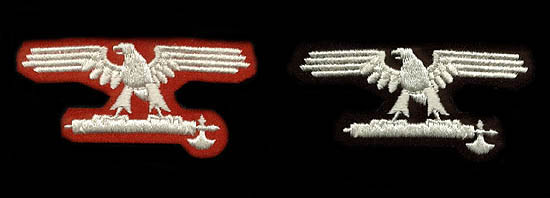
SS Italian Eagles
Above is a different style of Italian SS eagles that were questionable by many collectors if they were pre-WW2 or German made. They are a bit smaller in size and have a gray-green backing material.
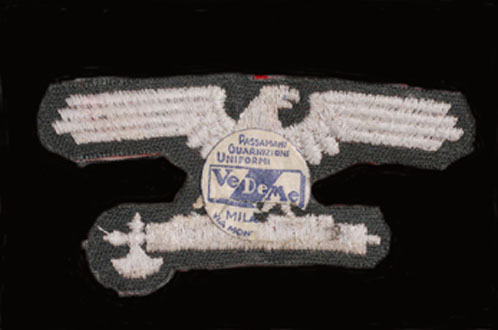
Recently new information has surface about these style of Italian SS eagles. Illustrated is the reverse of the SS Italian insignia showing a label attached from the Italian firm "VeDeMe" from Milano. This firm "VeDeMe, Industrie Riunite Venegoni , De Capitani e Menini" was the famous factory in Milan the name is an acronym for the owners Venegoni -De Capitani - Menini) specializing in production of banners, signs, badges of high quality during WW2.
. At least it provides some proof that these style of SS Italian eagles were produced during WW2.
[ Front
Page] [Top ][Previous
Page ] [Next Page]
|
|
|















